Concert Review: Anvil
(San Francisco, CA, The Fillmore, 06-02-10)
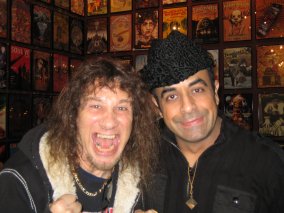 Anvil reminds me of Levi’s jeans and Twinkies, brands that have weathered a sea of trends. Regardless of current music and clothing trends, Steve “Lips” Kudlow (“SK”) plays and wears what he desires with a carefree dismissal of whether he is hip or fashionable. Any doubt about SK’s disinterest in musical trends is laid to rest by comparing Anvil’s first two records, Hard ‘N’ Heavy (1981) and Metal on Metal (1982), with Anvil’s latest record, This is Thirteen (2007). These records sound similar. Any doubt about SK’s carefree attitude about clothing trends is laid to rest by his appearance. SK continues to wear the metal head regalia that came to prominence in the early 1980’s, sneakers, snug-fitting black jean pants, rock t-shirt, and denim jacket with optional sheepskin interior lining.
Anvil reminds me of Levi’s jeans and Twinkies, brands that have weathered a sea of trends. Regardless of current music and clothing trends, Steve “Lips” Kudlow (“SK”) plays and wears what he desires with a carefree dismissal of whether he is hip or fashionable. Any doubt about SK’s disinterest in musical trends is laid to rest by comparing Anvil’s first two records, Hard ‘N’ Heavy (1981) and Metal on Metal (1982), with Anvil’s latest record, This is Thirteen (2007). These records sound similar. Any doubt about SK’s carefree attitude about clothing trends is laid to rest by his appearance. SK continues to wear the metal head regalia that came to prominence in the early 1980’s, sneakers, snug-fitting black jean pants, rock t-shirt, and denim jacket with optional sheepskin interior lining.
On Saturday, February 6, 2010, Anvil played The Fillmore in San Francisco. Anvil played 13 songs during an 83-minute set from 9:22 to 10:45. The festivities, or more appropriately, metalities, are discussed in greater detail below.
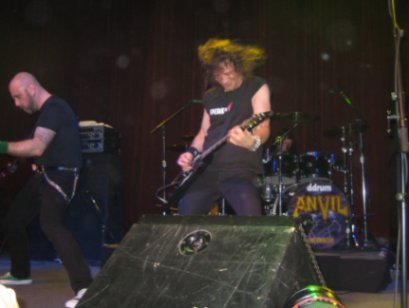
1. March of the Crabs (Metal on Metal record, 1982) was the first of four songs Anvil performed off Metal on Metal, an instrumental that clocks in at over 2:30 seconds. I admire Anvil for having the confidence to play an instrumental as the opening song. Most bands would not venture to perform an instrumental song, particularly as the set opener, because it leaves them “exposed and naked.” [Neither alarms SK. After all, SK displays his family jewels in “Anvil! The Story of Anvil” documentary (2009).] The lack of vocals that otherwise adds a layer to the musical canvas means musicians have to be confident in their musicianship to rely solely on their instrument-playing skills. SK masterfully ran off a battery of riffs on his battle-scarred, black flying V guitar, one of two that has comprised his arsenal for at least 21 years, while Glenn Gyorffy (aka Glenn Five/G5) (“G5”) played a maroon five-string Gibson Thunderbird bass.
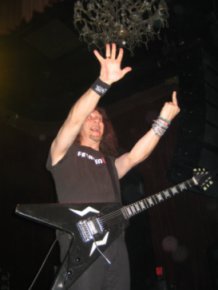 2. 666 (Metal on Metal, 1982) is a powerful, fast-paced song clearly demonstrating the band’s thrash roots and why Metallica, Slayer, and Anthrax cite Anvil as an influence. At the conclusion of the song SK displayed the sign language version of the song title, his open right hand displaying five digits and his left hand displaying, what else, the middle finger.
2. 666 (Metal on Metal, 1982) is a powerful, fast-paced song clearly demonstrating the band’s thrash roots and why Metallica, Slayer, and Anthrax cite Anvil as an influence. At the conclusion of the song SK displayed the sign language version of the song title, his open right hand displaying five digits and his left hand displaying, what else, the middle finger.
3. School Love (Hard ‘N’ Heavy, 1981). Before School Love SK said, “We are so lucky to play at this venue.” SK wore a black muscle shirt with the phrase, “freaken eh” printed in white and red lettering on his chest, black jean pants, studded belt, white sneakers, and a black sweatband on his right arm. Anvil launched into School Love, a song with a catchy chorus and verse. This is a fairly light rock song, Anvil’s lightest in an otherwise heavy set.
4. Winged Assassins (Forged in Fire, 1983). SK introduced the next song as “an anti-war song.” Robb Reiner (“RR”) started the punishing song by subjecting his floor toms to some heavy-handed beating. RR wore a black snap button leather vest, long-sleeve black cotton shirt, black jeans, and a black bandana atop his head. RR played a black-colored ddrum drum set with double bass drums featuring the Anvil logo and lightning bolts in each bass drum head along with the word “Robb” in one drum head and “Reiner” in the other. Winged Assassins has an Iron Maidenesque quality to it. After SK’s solo, RR and G5 provided rollicking drum beats and bass lines, with G5 spreading his legs and using his fingers to nimbly pluck his bass strings without a pick a la Steve Harris (Iron Maiden bassist). [G5 looked as if he was stretching for a heavy duty sumo wrestling session. I anticipated seeing G5 take his pants off to reveal a white mawashi (i.e., cloth worn to cover the private area), clap his hands, stomp his feet, and throw salt over his shoulders.
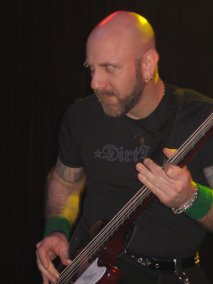 5. This Is Thirteen (This is Thirteen, 2007). Before This Is Thirteen SK said, “I do not fit your typical rocker stereotype. I am a music fan. It sucks when musicians do not come out and meet their fans. After the show I want to meet everyone. You have been to my house. You know my mother” [referring to scenes from “Anvil! The Story of Anvil” documentary]. I felt bad for the fans who paid the additional money above and beyond the $17 face value ticket price for a pre-show chance to meet the band, including obtaining a copy of This is Thirteen, “Anvil! The Story of Anvil” DVD and Anvil fanny pack. However, judging from SK’s graciousness and friendliness when I met him, he likely would have reached in his pants pocket and refunded the money requested by any disgruntled fan. [Given RR’s onscreen penchant to casually smoke marijuana as if sucking on tic tacs, it is safer for SK to perform this task because RR may inadvertently pull out a roach in lieu of currency, and not of the insect variety.]
5. This Is Thirteen (This is Thirteen, 2007). Before This Is Thirteen SK said, “I do not fit your typical rocker stereotype. I am a music fan. It sucks when musicians do not come out and meet their fans. After the show I want to meet everyone. You have been to my house. You know my mother” [referring to scenes from “Anvil! The Story of Anvil” documentary]. I felt bad for the fans who paid the additional money above and beyond the $17 face value ticket price for a pre-show chance to meet the band, including obtaining a copy of This is Thirteen, “Anvil! The Story of Anvil” DVD and Anvil fanny pack. However, judging from SK’s graciousness and friendliness when I met him, he likely would have reached in his pants pocket and refunded the money requested by any disgruntled fan. [Given RR’s onscreen penchant to casually smoke marijuana as if sucking on tic tacs, it is safer for SK to perform this task because RR may inadvertently pull out a roach in lieu of currency, and not of the insect variety.]
Anvil performed This is Thirteen, the first of three songs off This is Thirteen, a song with an eerie vibe featuring a straightforward introductory drum beat by RR and a plodding chord progression by SK reminiscent of Black Sabbath. This is a powerful song with an evil tinge. [The song is so dark and brooding I thought SK would come out on stage dressed in a hooded cloak worn by the grim reaper or The Emperor from George Lucas’s science fiction film, “The Return of the Jedi” (1983), light a candelabra, and summon spirits using a ouija board.] During SK’s guitar solo, G5 went back to RR’s drum set and placed his foot on the one-foot high black-colored drum riser. G5 wore a black t-shirt with the phrase, “Dirt Bag” printed in grey letters on his chest, black jean pants (with two chains extending from his belt loop to his back pocket), studded belt, green Converse sneakers, and green sweatbands.
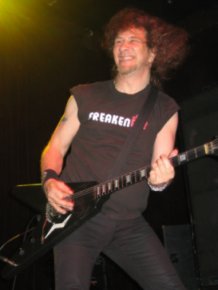 6. Mothra (Metal on Metal, 1982) is an up tempo song with a chugging riff. SK’s voice struggled during the first verse, but was then in fine form. SK effortlessly played a guitar solo. [SK played with such fluidity he would have been able to crochet while wailing on his flying V.] G5 periodically used his right fist to slam on the body of his bass. Following SK’s guitar solo, SK played power chords galore. RR played three drum beats on his floor toms after which SK and G5 stopped playing. SK lifted his guitar to his mouth and repeatedly shouted “yeah” into the guitar pickups, using them as a makeshift microphone. Interestingly, SK’s voice reverberated through his guitar amplifiers in a muffled tone prompting the audience to shout “yeah” back. SK pulled out his weapon of choice, a silver dildo from his right rear pants pocket. With a sly grin from ear to ear, SK held his trademark weapon in the air, basking in the moment as the dildo shimmered in the spotlight. [SK held the dildo with such pride and poise he looked like the final runner in the Olympic torch relay given the noble task of running to the cauldron placed atop a grand staircase and using the torch, in this case a dildo, to signify the commencement of the Olympic Games.] SK sat on a stage monitor stage front,
6. Mothra (Metal on Metal, 1982) is an up tempo song with a chugging riff. SK’s voice struggled during the first verse, but was then in fine form. SK effortlessly played a guitar solo. [SK played with such fluidity he would have been able to crochet while wailing on his flying V.] G5 periodically used his right fist to slam on the body of his bass. Following SK’s guitar solo, SK played power chords galore. RR played three drum beats on his floor toms after which SK and G5 stopped playing. SK lifted his guitar to his mouth and repeatedly shouted “yeah” into the guitar pickups, using them as a makeshift microphone. Interestingly, SK’s voice reverberated through his guitar amplifiers in a muffled tone prompting the audience to shout “yeah” back. SK pulled out his weapon of choice, a silver dildo from his right rear pants pocket. With a sly grin from ear to ear, SK held his trademark weapon in the air, basking in the moment as the dildo shimmered in the spotlight. [SK held the dildo with such pride and poise he looked like the final runner in the Olympic torch relay given the noble task of running to the cauldron placed atop a grand staircase and using the torch, in this case a dildo, to signify the commencement of the Olympic Games.] SK sat on a stage monitor stage front, 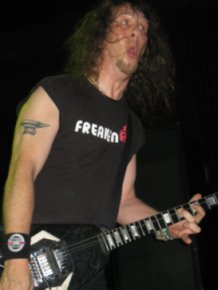 gripped the dildo with might in his left hand, much as he has done for at least 26 years, and ran it up and down his guitar neck, substituting the dildo for a guitar slide. SK switched the dildo to his right hand, demonstrating his dexterity as he tapped the dildo on his guitar strings while strumming chords with his left hand. Some of the audience members had a mesmerized look on their face, akin to the look on the faces of those who witnessed Jimi Hendrix light his Fender Stratocaster guitar on fire at London’s Astoria club (03-31-67) and the Monterey International Pop Festival (06-18-67). True, SK’s antics are not as earth shattering as Hendrix’s, but how many guitarists are able to captivate an audience by playing a guitar with a fake penis?!SK got up from the stage monitor and returned his weapon (i.e., dildo) to its holster (i.e., rear pants pocket). SK played a two-minute guitar solo that included a chugging chord progression he played progressively slower. I would have omitted this latter solo as the highlight was the solo with the dildo. The subsequent solo caused the song to drag a bit and took away the momentum created by witnessing SK a man play a guitar with a prosthetic penis. At the end of the song SK went back to the four guitar amplifiers located at the rear of stage left for guitar feedback a la Ritchie Blackmore (former Deep Purple and Rainbow guitarist).
gripped the dildo with might in his left hand, much as he has done for at least 26 years, and ran it up and down his guitar neck, substituting the dildo for a guitar slide. SK switched the dildo to his right hand, demonstrating his dexterity as he tapped the dildo on his guitar strings while strumming chords with his left hand. Some of the audience members had a mesmerized look on their face, akin to the look on the faces of those who witnessed Jimi Hendrix light his Fender Stratocaster guitar on fire at London’s Astoria club (03-31-67) and the Monterey International Pop Festival (06-18-67). True, SK’s antics are not as earth shattering as Hendrix’s, but how many guitarists are able to captivate an audience by playing a guitar with a fake penis?!SK got up from the stage monitor and returned his weapon (i.e., dildo) to its holster (i.e., rear pants pocket). SK played a two-minute guitar solo that included a chugging chord progression he played progressively slower. I would have omitted this latter solo as the highlight was the solo with the dildo. The subsequent solo caused the song to drag a bit and took away the momentum created by witnessing SK a man play a guitar with a prosthetic penis. At the end of the song SK went back to the four guitar amplifiers located at the rear of stage left for guitar feedback a la Ritchie Blackmore (former Deep Purple and Rainbow guitarist).
7. Flying Blind (This is Thirteen, 2007). Before Flying Blind SK said, “I am glad to be alive guys!” [The joy and enthusiasm contained in the intonation in SK’s voice and expression on his face were patently clear. SK’s sincerity was as obvious as the stench of manure at a rodeo and beer at a fraternity keg party.] SK asked, “Have any of you ever been on a blind date? I got blisters!” SK’s jovial nature demonstrated his sense of humor and ability to connect with the audience on a personal level. This natural ability is partially responsible for Anvil’s newfound success and ability to maintain a devoted fan base since 1978. Admittedly, Paul Stanley (Kiss lead vocalist and rhythm guitarist) used a similar catch line when asked by a journalist to describe his firs sexual experience during the Australian leg of Kiss’s Unmasked tour (1980). Paul quipped, “I got hand blisters.” Regardless, like a classic Rodney Dangerfield joke, SK’s joke was still effective. The band performed Flying Blind, an up tempo song with a country tinge and “shuffle” feel. G5 impressively played a black 12-string bass, his picking fingers nimbly moving across the strings with great speed akin to Tom Araya (Slayer bassist) flailing away the frenetic bass lines to Slayer’s Hell Awaits from the Hell Awaits record (1985). It was impressive to see a metal band pull off such a song, but it did not quite fit in with the rest of the set. [I expected to see Garth Brooks stomp on stage with his 10-gallon cowboy hat and begin line dancing with SK and G5.]
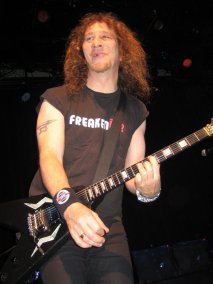 8. Thumb Hang (This is Thirteen, 2009 (re-release)). Before Thumb Hang, SK caught a black bra in mid air and mounted it on his microphone stand as if proudly displaying his trophy. [Given the gargantuan size of the bra I was surprised the stand did not sway like the Leaning Tower of Pisa.] After regaining his arm strength from mounting his enormous prize, SK paid homage to one of his heroes, Ronnie James Dio (Black Sabbath and Dio vocalist). “Ever since I was a kid I listened to Black Sabbath. Forty years later I am still a kid and still listen to Black Sabbath. I got to know the guys in Black Sabbath because Anvil opened for them. Ronnie James Dio is home undergoing chemotherapy. He is beating the [stomach] cancer.” The audience enthusiastically clapped. SK introduced Thumb Hang as a song “inspired by the boys” (i.e., Black Sabbath). Thumb Hang begins as a slow tempo song with plenty of “aah” “aahs,” and, approximately 90 seconds into the song, shifts to a fast tempo followed by a fiery SK guitar solo on his flying V accompanied by G5 on his maroon Gibson Thunderbird bass. After SK’s solo, the tempo resumed a slow pace. Anvil was wise to add this strong rocker as a bonus track to the version of This is Thirteen re-released by VH1 Records in 2009.
8. Thumb Hang (This is Thirteen, 2009 (re-release)). Before Thumb Hang, SK caught a black bra in mid air and mounted it on his microphone stand as if proudly displaying his trophy. [Given the gargantuan size of the bra I was surprised the stand did not sway like the Leaning Tower of Pisa.] After regaining his arm strength from mounting his enormous prize, SK paid homage to one of his heroes, Ronnie James Dio (Black Sabbath and Dio vocalist). “Ever since I was a kid I listened to Black Sabbath. Forty years later I am still a kid and still listen to Black Sabbath. I got to know the guys in Black Sabbath because Anvil opened for them. Ronnie James Dio is home undergoing chemotherapy. He is beating the [stomach] cancer.” The audience enthusiastically clapped. SK introduced Thumb Hang as a song “inspired by the boys” (i.e., Black Sabbath). Thumb Hang begins as a slow tempo song with plenty of “aah” “aahs,” and, approximately 90 seconds into the song, shifts to a fast tempo followed by a fiery SK guitar solo on his flying V accompanied by G5 on his maroon Gibson Thunderbird bass. After SK’s solo, the tempo resumed a slow pace. Anvil was wise to add this strong rocker as a bonus track to the version of This is Thirteen re-released by VH1 Records in 2009.
9. White Rhino (Still Going Strong, 2002). Before White Rhino, SK said, “It is time to recharge.” SK unplugged the guitar cord from his guitar so he could switch to his other axe. Before plugging the cord into his second guitar, SK inserted the cord into his mouth, much like a sword swallower. When the metal end of the chord struck SK’s tongue it created crackling and feedback in his amplifiers. SK jokingly pointed to his mouth and said, “This is my new guitar! [In such a case, SK could add “Loudmouth” as another nickname.] I have been friends with Robb since 1973. Nothing makes him happier and to smile than to hear the crowd.” The audience roared as the spotlight shined on RR. RR stood up behind his massive drum set, displaying a beaming smile, something that, by RR’s own admission, he does not often do.
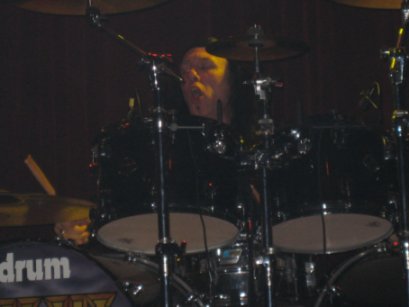
Anvil performed White Rhino, the second instrumental of the set and the only song from the 1988 to 2006 time period. My admiration for Anvil grew further. Most bands would not dare perform one instrumental song, much less two. Anvil could care less about convention. [SK would rather raise his middle finger right before launching into whatever song his heart desired, be it an instrumental, a polka tune, or a waltz where he decides to embrace RR and gracefully dance across the stage in a flowing sequin dress.]
White Rhino is an up tempo song with a thrash feel. RR delivered a solid drum beat with drum fills for flavor. G5 pounded away on his bass’s body. SK got on his knees and burned on his flying V. White Rhino included a two-minute RR drum solo during which G5 left the stage. However, SK maintained a nondescript presence in the rear of the stage by his amplifiers tuning his guitar. After he was done tuning, SK walked within a few feet of RR’s drum riser and intently watched and listened to RR’s impressive solo with admiration and glee, refusing to take his eyes of his metal brethren since high school. When RR struck the last beats on his snare drum and floor tom, SK clenched his fist signaling that RR had “nailed it.” SK exclaimed, “How amazing is that! Robb Reiner rocks man! No. San Francisco rocks man!”
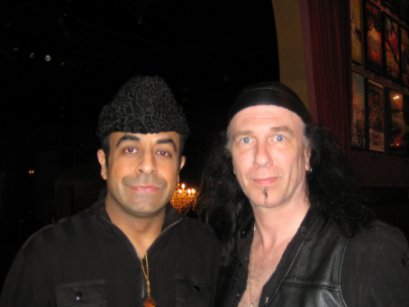
10. Mad Dog (Strength of Steel, 1987). Before Mad Dog, a song for which Anvil recorded a music video that received a fair amount of air play on MTV’s “Headbangers Ball,” SK said, “I used to own a bulldog named Beast. Beast liked strangers. He would mount them and ride!” SK told a brief story about how he sold Beast to an unsuspecting girl in a pet store. “I wrote a song about my bulldog. It is called Mad Dog.” Mad Dog is an up tempo song with a catchy chorus and chugging riff. At the end of the song SK shouted, “San Francisco, I am just a mad mad dog!”
11. Forged in Fire (Forged in Fire, 1983) features a wicked riff and ominous guitar trill (i.e., rapid alternation of two adjacent tones). G5 played his 12-string bass. During the mid-section of the song G5 and SK approached each other center stage, stood within a few feet of each other and jammed. Forged in Fire, along with This Is Thirteen, were undeniably the heaviest songs Anvil performed. These songs celebrate what is metal in its purest form, loud power chords and drum beats that hit the listener in the gut with such force he is left breathless.
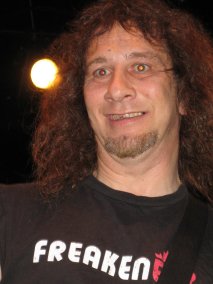 12. Metal on Metal (Metal on Metal, 1982). SK introduced Metal on Metal as the “last song for you.” Metal on Metal is prominently featured in “Anvil! The Story of Anvil” documentary and features a catchy chord progression. Following SK’s solo, SK and G5 raised their hands above their heads and clapped, encouraging the audience to follow suit. As the stage lights shined into the crowd, I looked back at the audience from front row and was pleased to see the 1,200-seat theater approximately 75 percent full, a much healthier turn out than the handful of fans in attendance at Anvil’s Munich, Germany show captured on “Anvil! The Story of Anvil.” At the end of the song SK said, “San Francisco, I had a magnificent night. Thank you and god bless.” The band left the stage at 10:40 and returned in one minute to play one additional song.
12. Metal on Metal (Metal on Metal, 1982). SK introduced Metal on Metal as the “last song for you.” Metal on Metal is prominently featured in “Anvil! The Story of Anvil” documentary and features a catchy chord progression. Following SK’s solo, SK and G5 raised their hands above their heads and clapped, encouraging the audience to follow suit. As the stage lights shined into the crowd, I looked back at the audience from front row and was pleased to see the 1,200-seat theater approximately 75 percent full, a much healthier turn out than the handful of fans in attendance at Anvil’s Munich, Germany show captured on “Anvil! The Story of Anvil.” At the end of the song SK said, “San Francisco, I had a magnificent night. Thank you and god bless.” The band left the stage at 10:40 and returned in one minute to play one additional song.
13. Jackhammer (Backwaxed, 1985). SK resumed his entertaining storytelling ritual. “I used to share a hotel room with our [former] bass player. He was a ladies man. One night he brought a sleazy lady to the hotel room. I woke up and she asked if she could do me! Her name was Jonah but I called her Jackhammer.” Jackhammer, along with 666, were the fastest songs of the night featuring a frenetic guitar chord progression and guitar solo. SK sang the verses and chorus in rapid (i.e., “jackhammer”) fashion. Jackhammer was an excellent choice to close the set.
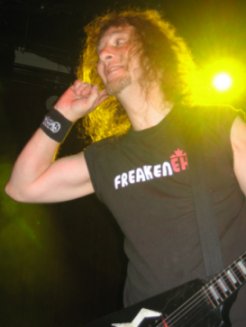 At 10:45 the band took a bow ending the metal onslaught. SK came up to the microphone for one last time and said, “Give me five to 10 minutes to towel off, and I will come out and meet each and every one of you who hangs out.” Two flashback memories are worthy of mention. First, I recall seeing guitar maestro Yngwie Malmsteen perform at The Independent (“TI”) club in San Francisco on November 9, 2005. In contrast to SK’s minimal stage gear comprised of four mid-size guitar amplifiers for a 1,200-seat theater, Yngwie elected to place 14, yes 14, 100-watt Marshall amplifiers and Marshall heads on the tiny stage of the 375-seat club. After I reached front row at TI and observed the mountain of Marshalls within 20 feet of me, I began to salivate at the impending audio onslaught. I knew one strum of a power chord by Yngwie on his Fender Stratocaster would reduce my teeth to fine enamel dust. Upon closer inspection I realized Yngwie only had one of the 14 Marshall amplifiers and heads turned on. In contrast, SK did not feel a need for visual deception. Four road weary, mid-size guitar amplifiers sufficed for a venue three times as large as TI.
At 10:45 the band took a bow ending the metal onslaught. SK came up to the microphone for one last time and said, “Give me five to 10 minutes to towel off, and I will come out and meet each and every one of you who hangs out.” Two flashback memories are worthy of mention. First, I recall seeing guitar maestro Yngwie Malmsteen perform at The Independent (“TI”) club in San Francisco on November 9, 2005. In contrast to SK’s minimal stage gear comprised of four mid-size guitar amplifiers for a 1,200-seat theater, Yngwie elected to place 14, yes 14, 100-watt Marshall amplifiers and Marshall heads on the tiny stage of the 375-seat club. After I reached front row at TI and observed the mountain of Marshalls within 20 feet of me, I began to salivate at the impending audio onslaught. I knew one strum of a power chord by Yngwie on his Fender Stratocaster would reduce my teeth to fine enamel dust. Upon closer inspection I realized Yngwie only had one of the 14 Marshall amplifiers and heads turned on. In contrast, SK did not feel a need for visual deception. Four road weary, mid-size guitar amplifiers sufficed for a venue three times as large as TI.
Second, the bewildered look on SK’s face when we met and he first took a gander at my karakul hat (i.e., hat made from sheep fur) and cherry red Dr. Martens combat boots reminded me of the look on the faces of airport security officials. SK certainly had no ill intentions because he demonstrated bewilderment, not suspicion. Regardless, SK’s prolonged stare brought back fond memories of the “special treatment” I receive at 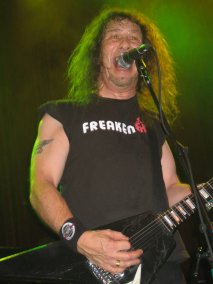 airports, dating back to the 1980’s, long before the heightened security implemented after the unfortunate September 11th terrorist attacks. The special treatment is a fun way for me to keep myself amused during boring trips to the airport. I recall one occasion in July 1991 where I gave my older brother and his then-wife a ride to the airport. The lovely newlyweds were in a relaxed state looking forward to a pleasant Florida honeymoon. My brother stood at the airline ticket counter. I stood approximately 10 feet behind my brother. In my periphery I noticed a security guard donning a plastic badge staring at me. I got bored and decided to entertain myself at the security guard’s expense. I started flashing glances at the guard with an insane look in my eyes, similar to the one Jack Nicholson flashed as he chopped through the bathroom door in Stanley Kubrick’s psychological horror film, “The Shining” (1980). After the third gaze, I noticed the guard getting uneasy, whispering something to his colleagues via his walkie talkie shoulder speaker. The guard walked toward me, prompting me to non-chalantly walk up next my brother positioned between the guard and me. The guard sternly said to my brother, “Where are you traveling to? Let me see your passport.” My brother, who has a thinner skin for differential treatment and was oblivious to the mental stamina test I subjected the guard to, became infuriated and shouted, “I am only going to Florida! Why would I be carrying my passport! What do you want with my passport!” [My brother’s complexion morphed so quickly I thought he was a chameleon trying to blend with a bed of deep red roses.] The guard, who was now joined by two of his colleagues, thereby comprising The Three Stooges, passively nodded, ignoring my brother’s tirade, and repeated, “Just let me see your passport.” I gently tugged on my brother’s shirt and, with a feeble attempt to control my laughter, whispered the pre-interrogation events to him. My brother rolled his eyes and, with a stern frown and beads of perspiration on his glistening forehead stated, “Can’t you ever behave?!”
airports, dating back to the 1980’s, long before the heightened security implemented after the unfortunate September 11th terrorist attacks. The special treatment is a fun way for me to keep myself amused during boring trips to the airport. I recall one occasion in July 1991 where I gave my older brother and his then-wife a ride to the airport. The lovely newlyweds were in a relaxed state looking forward to a pleasant Florida honeymoon. My brother stood at the airline ticket counter. I stood approximately 10 feet behind my brother. In my periphery I noticed a security guard donning a plastic badge staring at me. I got bored and decided to entertain myself at the security guard’s expense. I started flashing glances at the guard with an insane look in my eyes, similar to the one Jack Nicholson flashed as he chopped through the bathroom door in Stanley Kubrick’s psychological horror film, “The Shining” (1980). After the third gaze, I noticed the guard getting uneasy, whispering something to his colleagues via his walkie talkie shoulder speaker. The guard walked toward me, prompting me to non-chalantly walk up next my brother positioned between the guard and me. The guard sternly said to my brother, “Where are you traveling to? Let me see your passport.” My brother, who has a thinner skin for differential treatment and was oblivious to the mental stamina test I subjected the guard to, became infuriated and shouted, “I am only going to Florida! Why would I be carrying my passport! What do you want with my passport!” [My brother’s complexion morphed so quickly I thought he was a chameleon trying to blend with a bed of deep red roses.] The guard, who was now joined by two of his colleagues, thereby comprising The Three Stooges, passively nodded, ignoring my brother’s tirade, and repeated, “Just let me see your passport.” I gently tugged on my brother’s shirt and, with a feeble attempt to control my laughter, whispered the pre-interrogation events to him. My brother rolled his eyes and, with a stern frown and beads of perspiration on his glistening forehead stated, “Can’t you ever behave?!”
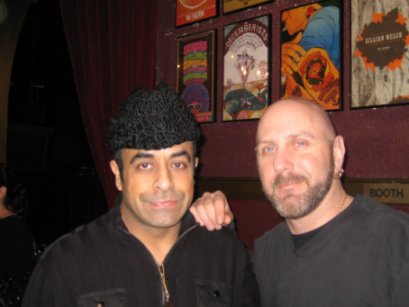
Venue: The Fillmore (“TF”) is a historic San Francisco theater that, in the mid-1960s, under the direction of legendary late Bay Area rock promoter Bill Graham, was the site of psychedelic and rock music and counterculture. TF’s early days featured acts such as Led Zeppelin, The Who, Pink Floyd, Cream, The Grateful Dead, Jefferson Airplane, Jimi Hendrix Experience, and The Doors. TF is a 1,200-seat capacity venue with a standing room floor similar to an oversized dance hall. Positioned above the floor are 10 chandeliers. The second floor contains a bar and box seats, specifically, six box seats stage right and another two, along with the mixing room, across the stage. Opening Band: Attitude Adjustment.
Arash Moussavian, Entertainment Law Attorney
arashmoussavian@cal.berkeley.edu
http://www.linkedin.com/in/arashmoussavian
All photos taken by Arash Moussavian. This article and all photos are protected by copyright. Please contact me prior to use, or I will make shish kabab of your loins.
















